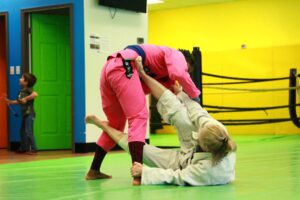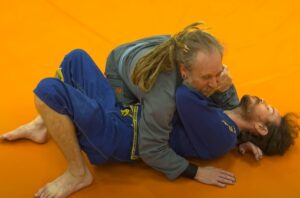 Innovations come from war for 2 reasons:
Innovations come from war for 2 reasons:
1. You’re under stress and you have to come up with something innovative, or else you’ll die.
2. You’re in a very specific situation which cultivates creativity in a manner which you might not otherwise use.
Put another way, necessity is the mother of invention. This old adage is nowhere more apparent than with situational sparring in BJJ.
I remember being in art school and having projects due by a certain date. When I was a freshman and sophomore, we had specific guidelines for each project: use a monochromatic scheme in elements of the piece; use contrasting image juxtaposition as a metaphor for a social concern; employ abstraction in the style of a certain artist. Then I remember when I was a junior and senior, and suddenly we didn’t have any constraints over the art we made. Contrary to what I might have believed previously, the resulting artwork while under restrictive guidelines was among some of the best stuff I made in all of my college career.
Having constraints over projects that were due caused me to have to think creatively within a specific framework. It also gave me a feeling of liberation that was apparent when I started working. The gist was this: because I was under the metaphorical gun, it was all right for me to create something that wasn’t all that impressive. Unexpectedly and ironically, that was where the really good stuff came from.
This creative drive transferred immediately and completely to grappling for me, and one of the most apparent examples throughout all of my jiu jitsu career has been situational sparring.
Putting yourself into positions you might not otherwise ever end up in will force you to abandon your preconceived notions of how the match is going to go, and focus on the task at hand. On one hand, you might discover that you really enjoy working from the top position of half guard when your partner has the underhook and your hips are switched (who knew?). On the other hand, even if you discover that you, in fact, still hate the positions you weren’t employing as a major part of your game, you will develop a much deeper understanding of the other side of the coin: what your opponent is going to be trying to achieve from the other side of that position.
A lot of the above concepts can be achieved simply by checking your ego completely and simply putting yourself in certain positions during open rolling sessions. However, two distinct obstacles keep this from coming to fruition:
1. There is no such thing as “ego-less” rolling. On the contrary, it is impossible for a competitive athlete in any sport to utterly change his or her nature. Ego is a large part of what drives the competitive spirit in all of us, and – used properly- ego can help you reach your goals, motivate you to become better, and ultimately motivate you to get back up and try again.
2. You may not, in fact, be able to achieve certain positions on all of your training partners. This may be because your training partners are simply tougher or more experienced than you, and so you can’t necessarily achieve a dominant position from which to practice on them. However, the opposite can actually be true! If you’re much more technical than your training partner, you may not achieve the exact desired situation from them, because they simply may not react accordingly in order to get you there.
Enter situational sparring.
Essentially, you want to limit your rolling to the specific area you’re exploring.
 Instead of spending 5 minutes rolling per round, and maybe 15 or 20 seconds in the position you want to work from (or no time at all), you get the entire round to work on your position. Escaping side control is a really easy one to visualize: your partner holds you and looks for a submission or to advance their position, and you try to escape back to guard (or get on top). Once either of you reaches your objective, you just restart again in the same position.
Instead of spending 5 minutes rolling per round, and maybe 15 or 20 seconds in the position you want to work from (or no time at all), you get the entire round to work on your position. Escaping side control is a really easy one to visualize: your partner holds you and looks for a submission or to advance their position, and you try to escape back to guard (or get on top). Once either of you reaches your objective, you just restart again in the same position.
This type of training can make months of rolling time count for years of experience.
Come continue thinking about BJJ with me over at BJJ Path. I have around 500 BJJ tutorials, some 2000 videos, and a bunch of ideas for you to consider for situational sparring.